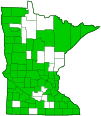stiff sunflower
(Helianthus pauciflorus ssp. pauciflorus)
Conservation • Description • Habitat • Ecology • Use • Distribution • Taxonomy
|
|
|||||||||||||
Description |
Stiff sunflower (ssp.pauciflorus) is an erect, annual forb that rises on a single stem from long, thick, branched, creeping rhizomes. It can be from 32″ to 78″ tall, though it is usually no more than 60″ in height. It often forms colonies. The stems are erect, green or reddish-brown, and unbranched or sparingly branched near the top. They are rough to the touch due to a moderate to dense covering of short, stiff, ascending to spreading hairs. The stems are usually leafless near the top. There are usually 8 to 15 leaf nodes below the inflorescence. Lower leaves are opposite, uppermost leaves are usually alternate. Lower and middle leaves are oblong lance-shaped to narrowly egg-shaped, relatively thick, and flat, not folded longitudinally. They are 3⅛″ to 10″ long and ¾″ to 2⅜″ wide, 2½ to 8 times as long as wide. They are wedge-shaped at the base and taper gradually to a sharp point at the tip with concave sides along the tip. The upper and lower surfaces are rough to the touch due to a moderate to dense covering of minute, stiff hairs. They are also sparsely to moderately covered with minute, stalkless, yellow glands. The margins are finely toothed to almost untoothed. The leaves have 3 main veins, a midvein and a pair of lateral veins that branch off the main vein well above the base and arch upward. The inflorescence is sometimes a solitary head, usually an open cluster of 2 to 10 flower heads at the end of the stem. The flower heads are on stalks that are 1 3 ⁄16″ to 4¾″ long. The whorl of bracts at the base of the flower head (involucre) is ⅝″ to ⅞″ in diameter. The bracts of the involucre are elliptic to egg-shaped and taper to a blunt or sharp point at the tip. The tips of the bracts are tightly appressed. The flower heads are 1½″ to 2½″ wide, the disk is ⅜″ to 1″ in diameter. There are 10 to 20 yellow ray florets and 75 or more reddish-brown to purple disk florets. The fruit is an achene. |
Height |
32″ to 60″ |
Flower Color |
Yellow ray florets, reddish-brown to purple disk florets |
Similar Species |
Stiff sunflower (Helianthus pauciflorus ssp. subrhomboideus) tends to be shorter, 12″ to 48″ in height. There are usually only 5 to 10 leaf nodes below the inflorescence. The uppermost leaves are usually opposite. The lower and middle leaves are shorter, 2″ to 4¾″ long. They are rhombic egg-shaped to lance-linear and taper to a blunt or sharp point at the tip with straight sides along the tip. |
Habitat |
Dry to moderately wet. Prairies, upland forest openings, pastures, railroads, roadsides. |
Ecology |
Flowering |
July to September |
Pests and Diseases |
Sunflower bullet gall midge (Pilodiplosis helianthibulla) makes ¼″ in diameter, almost globe-shaped galls on the leaves of plants in the genus Helianthus. |
Defense Mechanisms |
The roots exude chemicals that inhibit seed germination and growth of young plants. When in a dense colony, these chemicals may cause the inner plants to die, leaving a ring of living plants. |
Use |
|
Distribution |
||
|
Sources |
|
| 3/21/2024 | ||
Nativity |
||
Native |
||
Occurrence |
||
|
||
Taxonomy |
|
Kingdom |
Plantae (green algae and land plants) |
Subkingdom |
Viridiplantae (green plants) |
Infrakingdom |
Streptophyta (land plants and green algae) |
Superdivision |
|
Division |
Tracheophyta (vascular plants) |
Subdivision |
Spermatophytina (seed plants) |
Class |
|
Superorder |
Asteranae |
Order |
Asterales (sunflowers, bellflowers, fanflowers, and allies) |
Family |
Asteraceae (sunflowers, daisies, asters, and allies) |
Subfamily |
Asteroideae |
Supertribe |
Helianthodae |
Tribe |
Heliantheae (sunflowers and allies) |
Subtribe |
Helianthinae |
Genus |
Helianthus (sunflowers) |
Species |
|
The species epithet pauciflorus means few-flowered. |
|
|
|
Subordinate Taxa |
|
|
|
Synonyms |
|
Helianthus laetiflorus var. rigidus Helianthus rigidus |
|
Common Names |
|
few-leaved sunflower prairie sunflower stiff sunflower |
|
Glossary
Achene
A dry, one-chambered, single-seeded seed capsule, formed from a single carpel, with the seed attached to the membranous outer layer (wall) only by the seed stalk; the wall, formed entirely from the wall of the superior ovary, does not split open at maturity, but relies on decay or predation to release the contents.
Allelopathy
The release of a chemical toxin by one plant to inhibit the growth or germination of nearby competing plants.
Bract
Modified leaf at the base of a flower stalk, flower cluster, or inflorescence.
Involucre
A whorl of bracts beneath or surrounding a flower, flower head, or flower cluster.
Linear
Long, straight, and narrow, with more or less parallel sides, like a blade of grass.
Node
The small swelling of the stem from which one or more leaves, branches, or buds originate.
Rhizome
A horizontal, usually underground stem. It serves as a reproductive structure, producing roots below and shoots above at the nodes.
Visitor Photos |
||
Share your photo of this plant. |
||
This button not working for you? |
||
|
||
|
||
MinnesotaSeasons.com Photos |
||
|
||
|
||

Slideshows |
|

Visitor Videos |
||
Share your video of this plant. |
||
This button not working for you? |
||
|
Other Videos |
||
|

Visitor Sightings |
||
Report a sighting of this plant. |
||
This button not working for you? |
||
|
|
MinnesotaSeasons.com Sightings |
||

Created: Last Updated: © MinnesotaSeasons.com. All rights reserved. |
